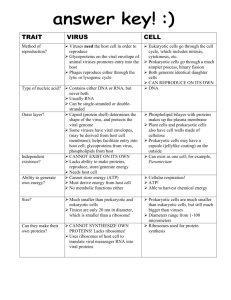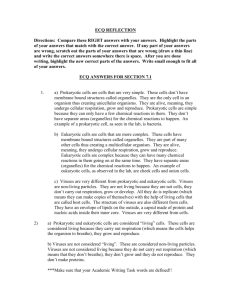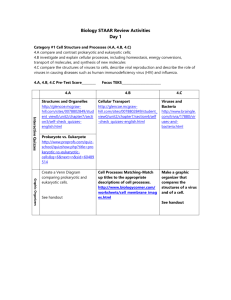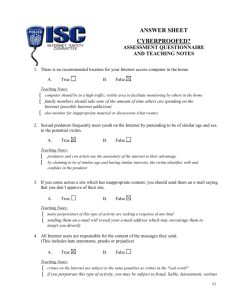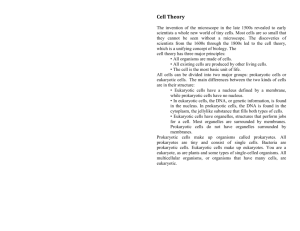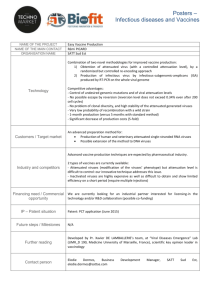Cell Structure, Function & Viruses: Biology Unit Plan
advertisement
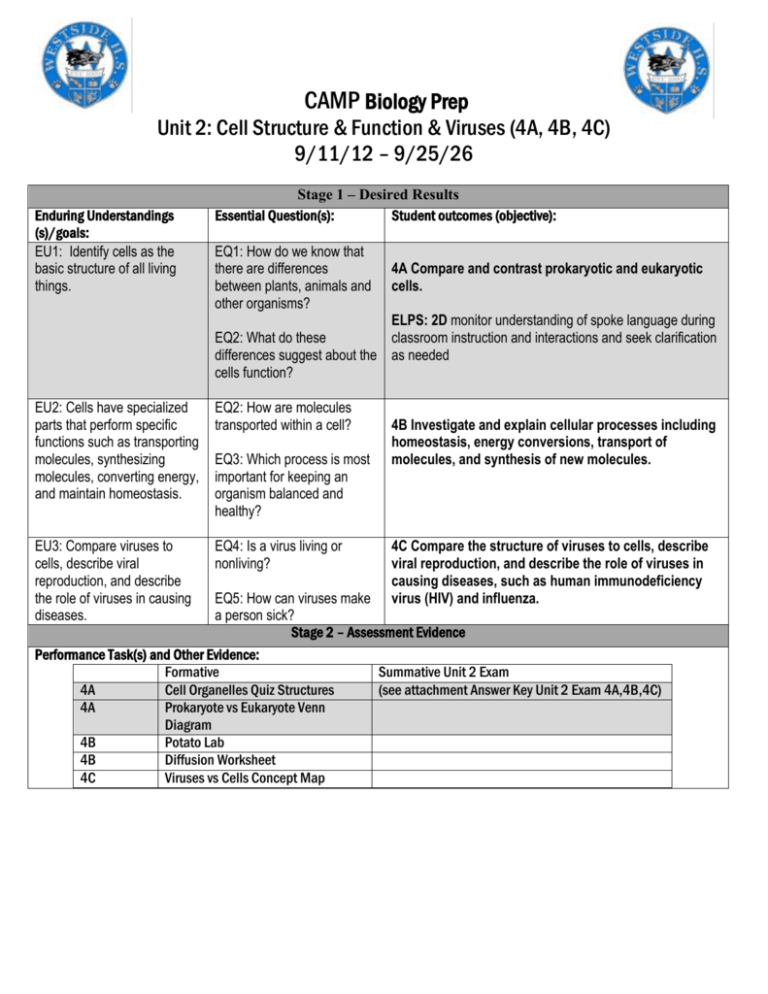
CAMP Biology Prep Unit 2: Cell Structure & Function & Viruses (4A, 4B, 4C) 9/11/12 – 9/25/26 Enduring Understandings (s)/goals: EU1: Identify cells as the basic structure of all living things. Stage 1 – Desired Results Essential Question(s): Student outcomes (objective): EQ1: How do we know that there are differences between plants, animals and other organisms? 4A Compare and contrast prokaryotic and eukaryotic cells. ELPS: 2D monitor understanding of spoke language during EQ2: What do these classroom instruction and interactions and seek clarification differences suggest about the as needed cells function? EU2: Cells have specialized parts that perform specific functions such as transporting molecules, synthesizing molecules, converting energy, and maintain homeostasis. EQ2: How are molecules transported within a cell? EU3: Compare viruses to cells, describe viral reproduction, and describe the role of viruses in causing diseases. EQ4: Is a virus living or nonliving? EQ3: Which process is most important for keeping an organism balanced and healthy? 4B Investigate and explain cellular processes including homeostasis, energy conversions, transport of molecules, and synthesis of new molecules. 4C Compare the structure of viruses to cells, describe viral reproduction, and describe the role of viruses in causing diseases, such as human immunodeficiency virus (HIV) and influenza. EQ5: How can viruses make a person sick? Stage 2 – Assessment Evidence Performance Task(s) and Other Evidence: Formative Summative Unit 2 Exam 4A Cell Organelles Quiz Structures (see attachment Answer Key Unit 2 Exam 4A,4B,4C) 4A Prokaryote vs Eukaryote Venn Diagram 4B Potato Lab 4B Diffusion Worksheet 4C Viruses vs Cells Concept Map Stage 3 – Learning Plan DIFFERENTIATION SCAFFOLD: Students learn organelles first, and then which cells have similar organelles. Students understand how cell membranes allow water & molecule to move in & out of cell. Students then compare structure & function of viruses to cells. ACCELERATE: PREAP – plasma membrane hydrophobic & hydrophilic heads & tails, dialysis lab GROUP: Intro to cells venn diagram activity, labs, review stations ELPS: 2D monitor understanding of spoken language during classroom instruction and interactions and seek clarification as needed Date Student Outcomes (Objectives) Day 1: 4A (S) Compare and contrast 9/11&9/12 prokaryotic and eukaryotic cells. Day 2: 9/16 4A (S) Compare and contrast prokaryotic and eukaryotic cells. Day 3: 9/17 4B Investigate and explain cellular processes including homeostasis, energy conversions, transport of molecules, and synthesis of new molecules. Day 4/5: 9/18 & 9/19 4B Investigate and explain cellular processes including homeostasis, energy conversions, transport of molecules, and synthesis of new molecules. Learning Activities: Student Assignment / Homework Warm-up: Group Review for Unit 1 Test Opening: Compare bacteria, animal & plant cell structures with Venn Diagram group activity. New Material: Cell Organelles Notes Assessment and Closing: Notebook Check! Opening: Unit 1 Test Question Review New Material: cont. Organelle Notes, Pro vs Euk notes Assessment and Closing: TPS function of cell membrane Opening: Osmosis Demo New Material: Homeostasis, Active & Passive Transport, Endo/Exocytosis, Iso/Hypo/Hyper Notes Assessment and Closing: ET: Why does an animal cell burst and why doesn’t a plant cell burst when too much water enters the cell? Opening: Difference between Pro vs Euk Venn Diagram in endo & exo class Practice: cont. Notes, Potato Lab Assessment and Closing: Prokaryote & Eukaryote Venn Diagram Day 6: 9/20 Day 7: 9/23 Day 8: 9/24 Day 9/10: 9/25 & 9/26 4C Compare the structure of viruses to cells, describe viral reproduction, and describe the role of viruses in causing diseases, such as human immunodeficiency virus (HIV) and influenza. 4C Compare the structure of viruses to cells, describe viral reproduction, and describe the role of viruses in causing diseases, such as human immunodeficiency virus (HIV) and influenza. Opening: Organelles Quiz New Material: Virus Notes Assessment and Closing: Why isn’t a virus a living organism? Organelles Quiz Potato Lab Due Opening: WU Virus vs Cells Venn Diagram Practice: Diffusion Worksheet in class Assessment and Closing: TPS Describe a bacteriophage. Diffusion Worksheet in class What is the structure & function? Opening: WU 4A (S) Compare and contrast Practice: Review for Unit 2 prokaryotic and eukaryotic cells. Test, Stations 4B Investigate and explain cellular processes including homeostasis, energy conversions, transport of molecules, and synthesis of new molecules. 4C Compare the structure of viruses to cells, describe viral reproduction, and describe the role of viruses in causing diseases, such as human immunodeficiency virus (HIV) and influenza. Summative Assessment TEKS: (4A, 4B, 4C) Diffusion Worksheet Due



